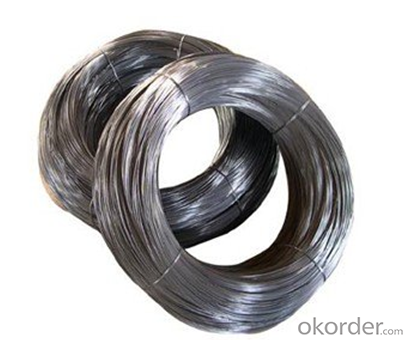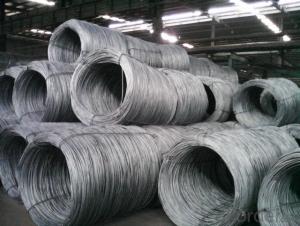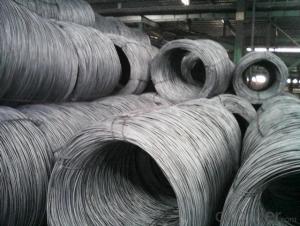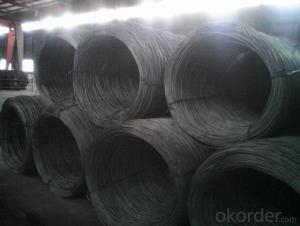Stainless Steel Wire with Grade: SS 200,300,400 series
- Loading Port:
- Tianjin
- Payment Terms:
- TT OR LC
- Min Order Qty:
- 100 m.t.
- Supply Capability:
- 2000 m.t./month
OKorder Service Pledge
OKorder Financial Service
You Might Also Like
Product Description:
OKorder is offering Stainless Steel Wire with Grade: SS 200,300,400 series at great prices with worldwide shipping. Our supplier is a world-class manufacturer of steel, with our products utilized the world over. OKorder annually supplies products to European, North American and Asian markets. We provide quotations within 24 hours of receiving an inquiry and guarantee competitive prices.
Product Applications:
Stainless Steel Wire with Grade: SS 200,300,400 series are ideal for structural applications and are widely used in the construction of buildings and bridges, and the manufacturing, petrochemical, and transportation industries.
Product Advantages:
OKorder's Stainless Steel Wire with Grade: SS 200,300,400 series are durable, strong, and resist corrosion.
Main Product Features:
· Premium quality
· Prompt delivery & seaworthy packing (30 days after receiving deposit)
· Corrosion resistance
· Can be recycled and reused
· Mill test certification
· Professional Service
· Competitive pricing
Product Specifications:
1.Grade: SS 200,300,400 series
2.Dia: 0.1mm-100mm
3.Length:500m-2000m/Reel
4.Surface: Bright
5.Certificate: Fortune 500, SGS, ISO 9001:2008
6.Test: Salt Spray over200 hours
7.MOQ:500kg
8.Delivery: Within 20 days
9.Packing: Reel, wooden box or according to your requirement
10.Payment terms: China Main Port or CIF ANY PORT
11. Application: Tie wire, pins, lashing, forming wire, filters, gaskets, elevators, safety wire, shaped and flat wire, conveyors, jewelry, springs, brush welding, electrical, wire line, craft and many more applications.
Main Grades | C % | Si % | S % | P % | Mn % | Cr % | Ni % | Mo % | Cu % |
S30400 | <0.08 | <0.75 | <0.015 | <0.045 | <2 | 18.05-19 | 8.01--8.25 | <0.6 | |
304H | 0.04-0.1 | <0.75 | <0.015 | <0.045 | <2 | 18.05-19 | 8.01--8.25 | <0.5 | |
304Hc1 | 0.03-0.05 | <0.75 | <0.015 | <0.045 | <2 | 18.05-19 | 8.01-8.25 | 1.2-1.6 | |
304Hc | 0.03-0.05 | <0.75 | <0.015 | <0.045 | <2 | 18.05-19 | 8.01--8.25 | 2-3 | |
304Hc3 | 0.03-0.05 | <0.75 | <0.015 | <0.045 | <2 | 18.05-19 | 8.01--8.25 | 3-3.5 | |
304ES | <0.08 | <0.75 | <0.015 | <0.045 | 2-3 | 16.05-17 | 6.01-6.3 | 1.5-3 | |
304M2 | 0.05-0.08 | <0.75 | <0.015 | <0.045 | 2-3 | 18-18.5 | 7-8.1 | <0.6 | |
304M3 | 0.05-0.08 | <0.75 | <0.015 | <0.045 | 2-3 | 18-18.5 | 8.01-8.25 | <0.6 | |
304L | <0.035 | <0.75 | <0.015 | <0.045 | <2 | 18.05-19 | 8.01--8.25 | <0.6 | |
321 | 0.04-0.08 | <0.75 | <0.015 | <0.045 | <2 | 17-18 | 8.01--8.25 | ||
316L | <0.035 | <0.75 | <0.015 | <0.045 | <2 | 16.05-17 | 10.01--10.35 | 2.01-2.2 | <1 |
316 | 0.04-0.08 | <0.75 | <0.015 | <0.045 | <2 | 16.05-17 | 10.01--10.35 | 2.01-2.2 | <1 |
316LCu | <0.035 | <0.75 | <0.05 | <0.045 | <2 | 16-17 | 10-10.5 | 2-2.25 | |
ER316L | <0.04 | 0.65 | <0.03 | <0.04 | 1.0-2.5 | 18-20 | 11.1-12 | ||
201CU | <0.08 | <0.75 | <0.015 | <0.045 | 8-9.5 | 13.05-14 | 4.01-4.25 | 2-3 | |
D667 | <0.08 | <0.75 | <0.015 | <0.045 | 13-14 | 13-14 | 0.7-1.5 | 1.5-3 | |
D665B | <0.08 | <0.75 | <0.015 | <0.045 | 14-16 | 10.05-11 | <1.2 | 0.5--1.5 | |
202B | 0.1-0.15 | <0.75 | <0.015 | <0.045 | 9-10 | 17.05-18 | 4.5-5 | ||
D669 | 0.08-1.0 | <0.75 | <0.015 | <0.045 | 14.5-16 | 11-12 | <1.2 | 0.5-1.5 | |
200CU | <0.08 | <0.75 | <0.015 | <0.045 | 11-12 | 13-14 | 1-2 | 1.5-2.5 |
FAQ:
Q1: Why buy Materials & Equipment from OKorder.com?
A1: All products offered byOKorder.com are carefully selected from China's most reliable manufacturing enterprises. Through its ISO certifications, OKorder.com adheres to the highest standards and a commitment to supply chain safety and customer satisfaction.
Q2: How do we guarantee the quality of our products?
A2: We have established an advanced quality management system which conducts strict quality tests at every step, from raw materials to the final product. At the same time, we provide extensive follow-up service assurances as required.
Q3: How soon can we receive the product after purchase?
A3: Within three days of placing an order, we will begin production. The specific shipping date is dependent upon international and government factors, but is typically 7 to 10 workdays.


- Q:How is steel wire rod heat treated to improve its mechanical properties?
- In order to enhance its mechanical properties, such as strength, hardness, and ductility, steel wire rod undergoes heat treatment. This involves a carefully controlled series of heating and cooling steps. The initial step in heat treating steel wire rod is annealing. This entails heating the steel to a specific temperature, usually above its critical temperature, and then allowing it to gradually cool. Annealing helps to relieve internal stresses and create a consistent microstructure, resulting in improved ductility and toughness. Following annealing, the steel wire rod may be subjected to quenching. This involves rapidly cooling the heated steel by immersing it in a liquid, like oil or water. This rapid cooling alters the microstructure of the steel, yielding a hard but brittle material. However, the steel becomes more prone to cracking and distortion. To counteract the brittleness caused by quenching, tempering is often employed. This process includes reheating the quenched steel to a lower temperature and then allowing it to cool slowly. This controlled cooling enables the steel to partially regain its ductility and toughness while maintaining some of its hardness. The specific temperature and duration of tempering can be adjusted to achieve the desired balance of mechanical properties. Depending on the specific requirements of the steel wire rod, other heat treatment processes such as normalization or case hardening may also be utilized. Normalization is similar to annealing but involves cooling the steel in still air, while case hardening involves adding a layer of harder material to the surface of the steel. Overall, the heat treatment of steel wire rod is a crucial step in enhancing its mechanical properties. By precisely controlling the heating and cooling processes, the steel can be transformed into a material that possesses the desired combination of strength, hardness, and ductility.
- Q:What are the main challenges in steel wire rod production?
- There are several main challenges in steel wire rod production that manufacturers typically face. One of the primary challenges is ensuring consistent quality and uniformity in the wire rod products. Since steel wire rods are used in various applications such as construction, automotive, and manufacturing industries, it is crucial to maintain strict quality control measures to meet the specific requirements and standards of each sector. Another significant challenge is optimizing the production process to achieve high productivity and efficiency. Steel wire rod production involves multiple stages, including melting, casting, rolling, and finishing. Each stage requires proper equipment, skilled operators, and precise control to minimize downtime, reduce waste, and maximize output. Manufacturers must continuously analyze and refine their production processes to achieve optimal efficiency. Furthermore, the global steel industry faces environmental challenges, including reducing energy consumption, minimizing carbon emissions, and implementing sustainable practices. Steel wire rod production consumes significant energy, especially during the melting and rolling processes. Manufacturers are constantly exploring innovative technologies and methods to improve energy efficiency, recycle waste materials, and reduce the environmental impact of their operations. Supply chain management is another critical challenge in steel wire rod production. Manufacturers need to ensure a steady supply of raw materials, such as iron ore and scrap metal, and maintain strong relationships with suppliers. Additionally, they must manage logistics efficiently to deliver finished products to customers promptly and reliably. Lastly, the steel wire rod market is highly competitive, with numerous domestic and international players. Manufacturers must continuously innovate and adapt to market trends, customer demands, and changing regulations to remain competitive. They need to invest in research and development, product diversification, and marketing strategies to differentiate themselves and maintain a strong market position. In summary, the main challenges in steel wire rod production revolve around quality control, production efficiency, environmental sustainability, supply chain management, and market competitiveness. Overcoming these challenges requires continuous improvement, technological advancements, and strategic decision-making to ensure success in this demanding industry.
- Q:What are the strength requirements for steel wire rod used in suspension bridge wire strands?
- The strength criteria for steel wire rod utilized in the wire strands of suspension bridges can differ based on various factors. Typically, the wire rod must possess a high level of tensile strength to endure the immense loads and stresses that suspension bridges encounter. The wire rod must have a minimum yield strength and ultimate tensile strength that either meets or surpasses the design requirements for the suspension bridge. The yield strength signifies the amount of stress that the wire rod can tolerate before it permanently deforms, while the ultimate tensile strength indicates the maximum stress the wire rod can withstand before it breaks. In addition to high strength, the wire rod must also demonstrate good ductility and toughness. Ductility refers to the material's ability to deform without fracturing, while toughness is its capacity to absorb energy without fracturing. These properties are vital for maintaining the structural integrity of the wire strands, as they allow the strands to flex and absorb dynamic loads, such as wind or vehicle vibrations, without experiencing failure. Furthermore, the wire rod should possess excellent corrosion resistance to ensure the longevity and durability of the suspension bridge. Over time, corrosion can weaken the wire strands, which compromises the bridge's structural integrity. Therefore, the wire rod must have a protective coating or be composed of corrosion-resistant alloys that can withstand exposure to environmental factors like moisture, saltwater, and pollutants. Lastly, the wire rod's dimensional requirements, including its diameter and surface finish, must also adhere to the specifications of the suspension bridge design. These dimensions are crucial for maintaining the desired strength and performance characteristics of the wire strands. In conclusion, the strength requirements for steel wire rod used in suspension bridge wire strands encompass high tensile strength, good ductility, toughness, corrosion resistance, and compliance with dimensional specifications. By meeting these requirements, the wire strands are capable of withstanding the significant loads and environmental conditions experienced by suspension bridges, ensuring their structural integrity and safety.
- Q:What are the main factors affecting the market expansion of steel wire rod?
- The main factors affecting the market expansion of steel wire rod include economic growth and industrial development, infrastructure investments, demand from various end-use industries such as automotive, construction, and manufacturing, availability and cost of raw materials, technological advancements in production processes, government policies and regulations, international trade dynamics, and competition from alternative materials.
- Q:What are the common production processes for rutherfordium-coated steel wire rod?
- The common production processes for rutherfordium-coated steel wire rod include initial steel wire rod production, surface cleaning and preparation, application of rutherfordium coating through a chemical or physical vapor deposition process, and final quality control and packaging.
- Q:How is steel wire rod used in the manufacturing of wire forms for solar panels?
- Steel wire rod is used in the manufacturing of wire forms for solar panels as it serves as the base material for creating the intricate shapes and structures required. Using steel wire rod, manufacturers can bend, shape, and weld the wire to create the framework and support structures for the solar panels. This ensures durability and strength, allowing the panels to withstand various environmental conditions and securely hold the photovoltaic cells in place.
- Q:How is steel wire rod classified based on its end-use applications?
- Steel wire rod is classified based on its end-use applications by considering factors such as the diameter, quality, and specific purpose of the steel wire. Different classifications include wire rod for automotive applications, construction purposes, industrial machinery, and various other sectors. The specific classification helps in meeting the unique requirements of each application and ensures the steel wire rod is tailored for its intended use.
- Q:How are steel wire rods used in the production of wire coat hangers?
- Steel wire rods are an essential component in the production of wire coat hangers. These rods serve as the primary material for creating the sturdy and durable frame of the hanger. To begin the manufacturing process, the steel wire rods are first carefully selected based on their quality and strength. They are then fed into a wire drawing machine, which pulls the rods through a series of dies to reduce their diameter and increase their length. This process is known as wire drawing and helps to attain the desired thickness and shape for the coat hanger. Once the wire rods have been properly drawn, they are then cut into specific lengths based on the desired size of the hanger. These cut rods are then sent to a bending machine, where they are shaped into the familiar triangular form of a coat hanger. The bending process involves applying precise pressure and force to the wire rods, allowing them to take on the desired shape without losing their structural integrity. After the bending process, the wire coat hangers may undergo additional treatments, such as polishing or coating, to enhance their appearance and protect them from rust or corrosion. These finishing touches contribute to the overall aesthetic appeal and longevity of the hangers. In summary, steel wire rods are used as the main material in the production of wire coat hangers. They undergo a series of processes, including wire drawing and bending, to create the final product. These hangers provide a sturdy and reliable solution for organizing and hanging clothing items while maintaining their shape and durability over time.
- Q:What are the different types of surface defects in steel wire rod?
- There are several different types of surface defects that can occur in steel wire rods. Some of the most common types include: 1. Scale: Scale is a thin, flaky oxide layer that forms on the surface of the wire rod during the manufacturing process. It can be caused by the reaction of the steel with oxygen in the air or with other elements in the production environment. Scale can affect the appearance of the wire rod and also impact its mechanical properties. 2. Decarburization: Decarburization refers to the loss of carbon from the surface of the wire rod. It can occur during the heating or cooling process and is often caused by exposure to a reducing atmosphere. Decarburization can weaken the wire rod and reduce its hardness and strength. 3. Surface cracks: Surface cracks are small, visible fissures that can develop on the surface of the wire rod. They can be caused by a variety of factors, including improper handling, excessive cooling rates, or stress during the manufacturing process. Surface cracks can lead to mechanical failures and reduce the overall quality of the wire rod. 4. Pits and dents: Pits and dents are small depressions or irregularities that can occur on the surface of the wire rod. They can be caused by a variety of factors, including the presence of impurities, improper handling, or the use of worn or damaged equipment. Pits and dents can affect the appearance of the wire rod and also impact its mechanical properties. 5. Lamination: Lamination refers to the separation or splitting of the wire rod into layers or sheets. It can be caused by a variety of factors, including improper rolling or cooling processes, the presence of impurities, or excessive stress. Lamination can weaken the wire rod and reduce its strength and ductility. 6. Corrosion: Corrosion is the process of gradual deterioration of the wire rod due to chemical reactions with its surroundings. It can be caused by exposure to moisture, chemicals, or other corrosive substances. Corrosion can affect the appearance and mechanical properties of the wire rod and can lead to premature failure. Overall, these different types of surface defects in steel wire rods can have a significant impact on the quality and performance of the product. It is important for manufacturers to closely monitor and control the production process to minimize these defects and ensure the production of high-quality wire rods.
- Q:What are the different types of steel wire rod surface cleaning tools?
- There are several different types of steel wire rod surface cleaning tools available in the market. These tools are designed to remove dirt, rust, and other contaminants from the surface of steel wire rods, ensuring a clean and smooth finish. One common type of cleaning tool is a wire brush. These brushes have stiff bristles made from steel or other materials that are capable of removing rust and loose debris from the surface of the wire rod. Wire brushes are available in various shapes and sizes, allowing users to choose the one that best fits their needs. Another type of cleaning tool is a sanding disc or wheel. These tools are typically made from abrasive materials such as sandpaper or grinding wheels. They are mounted on a rotating machine, and when pressed against the surface of the wire rod, they remove rust and other contaminants through abrasion. Chemical cleaning agents are also used to clean steel wire rod surfaces. These agents are usually applied using a brush or spray, and they work by breaking down and dissolving the contaminants on the surface. After application, the surface is usually rinsed with water to remove the cleaning agent and any remaining residue. Ultrasonic cleaners are another option for cleaning steel wire rod surfaces. These machines use high-frequency sound waves to create tiny bubbles in a cleaning solution. As the bubbles implode, they create a scrubbing action that removes dirt, rust, and other contaminants from the surface of the wire rod. In addition to these tools, there are also specialized cleaning machines available for larger-scale operations. These machines often use a combination of mechanical, chemical, and/or ultrasonic cleaning methods to ensure a thorough and efficient cleaning process. Overall, the choice of cleaning tool will depend on the specific needs and requirements of the user. It is important to consider factors such as the extent of contamination, the desired finish, and the size of the wire rod when selecting the appropriate cleaning tool.
1. Manufacturer Overview |
|
|---|---|
| Location | |
| Year Established | |
| Annual Output Value | |
| Main Markets | |
| Company Certifications | |
2. Manufacturer Certificates |
|
|---|---|
| a) Certification Name | |
| Range | |
| Reference | |
| Validity Period | |
3. Manufacturer Capability |
|
|---|---|
| a)Trade Capacity | |
| Nearest Port | |
| Export Percentage | |
| No.of Employees in Trade Department | |
| Language Spoken: | |
| b)Factory Information | |
| Factory Size: | |
| No. of Production Lines | |
| Contract Manufacturing | |
| Product Price Range | |
Send your message to us
Stainless Steel Wire with Grade: SS 200,300,400 series
- Loading Port:
- Tianjin
- Payment Terms:
- TT OR LC
- Min Order Qty:
- 100 m.t.
- Supply Capability:
- 2000 m.t./month
OKorder Service Pledge
OKorder Financial Service
Similar products
New products
Hot products
Hot Searches
Related keywords






























